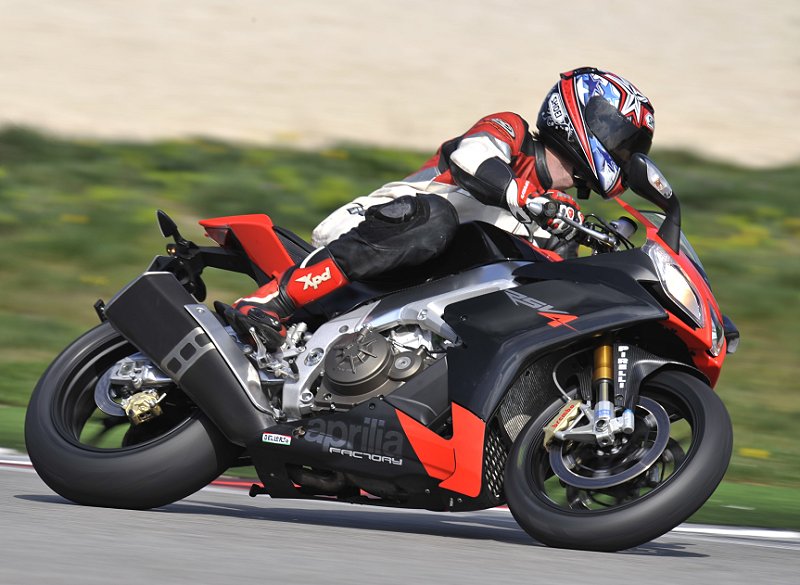
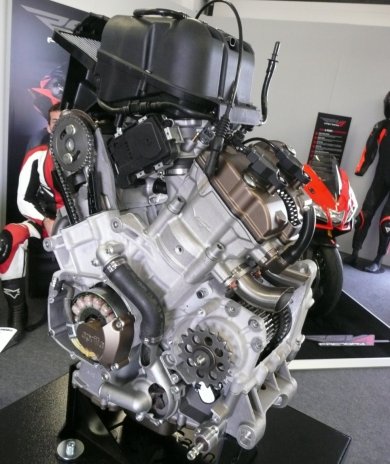
Unless you were a majority shareholder in Microsoft AND knew a Honda or Ducati dealership owner on a first name basis, your chances of owning a super sports V4 during the last 25 years were close to nil. Think about it, since the demise of the Honda VF1000R of the mid-eighties, V4 race-replica ownership meant having enough greenbacks and stature to access nearly unobtainable RC30’s, RC45’s or, much, much later, the even rarer Ducati Desmosedici RR. For two decades, sporting souls around the globe have been force-fed in-line fours, triples and V-Twins, told these were pure bliss, and generally led to believe they weren’t missing anything special. Well then, after just one session on the new four-pot RSV4 I thought . . . Wow! What a great engine layout!
Imagine something smaller than some current SuperSport 600’s and with a power bonus of 50-60 hp while losing nothing in terms of sheer flickability. Sounds too good? Well, Aprilia always knew how to wow us. They did so close to 10 years ago with the first “Mille”, a sport tool just too good to be a first try by what was at the time a scooter maker. Fast forward to the wonderful (but not fully understood) 2003 RSV 1000 (which I still love dearly). Now, they are at it again, shocking the world with an hyper-advanced scoot that must leave engineers in Japan scratching their heads in disbelief.
The story behind the RSV4 is much simpler than the crazy chain and gear cam drive of the V4 motor. Leo Mercanti, Aprilia’s new boss in the post-Ivano Beggio era, felt that a flagship hypersports tool was a must for a comeback by a company known for its (2 stroke) GP wins. The funds from big mama Piaggio were secured and work on the engine began from a clean sheet of paper, more or less. As much as I want to believe that Aprilia engineers sought the best possible configuration, I guess that the company’s love affair with narrow angle Vee’s (the Mille had 60 degrees between its cylinders) played a big part in the decision to go for a narrow 65 degree angle V4. Conceptually speaking, every outstanding feature of this smashing bike derives from this unique engine configuration. More than anything else, it’s the sheer compactness of the mechanical bits between the conventional twin spar frame that become evident the moment you swing a leg over the RSV4 . . . this thing is almost Ducati Twin narrow. Rock it side to side, and it feels dense yet light.
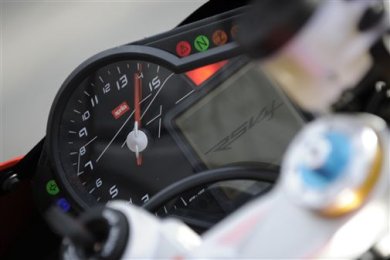
It’s a looker too, but this shouldn’t be a surprise to Aprilia fans. The offspring of the Venice based company always had an avant-garde slant, and uber-designer Miguel Galuzzi together with the man behind the cute Derbi Mulhacen, Jose Gonzales, have now pushed the limits even further. The minimal MotoGP-style bodywork is spare at some points, while other areas are almost ornate. The super pointy tailpiece with its deep fins, for instance, is simply wild. The front end has an angry animal look, which suits the RSV4 just fine. There’s also a fair bit of exposed mechanics to keep the motorheads happy. Not sure this ‘priller’s charm will be universal though, as I can imagine that some will find the design a bit extreme . . . even gothic, but Galuzzi and Co. have certainly crafted a SuperSport tool that isn’t easily forgettable, and that is no mean feat these days.
Neither is it easy to craft a dynamic riding experience that is so unique. It all starts with the size, or more specifically, the lack thereof. Compact as it is, the tiny Aprilia doesn’t feel cramped when you swing a leg over. My assigned mechanic peels the tire warmers while I blip the throttle, then I put my feet on the pegs before taking off and I make a mental note: high pegs! But this is forgotten in a hurry as the creamy V4 purrs through the lower end of the revs. While warming myself and the tires up, the sheer friendliness of the new mill — even from ridiculously low rpm’s — is remarkable. Just as friendly is the non-too-extreme relationship between seat and bars. Compared to other notable Italian big bore SuperSports (1198, F4), the riding position is far from being punishing.
While short shifting my way around the track, the engine response from as low as 3000 rpm is impressive. Chalk one up for the precise ride-by-wire throttle programming. Up to 7-8 K the power grows in linear fashion while remaining very controllable, at least in the middle “Sport” mode (there are three engine control positions: Track, Sport, and Road).
Things start to get more interesting as I get to know “upside down Misano” a bit better (circulation was changed from clockwise to counter-clockwise just two seasons ago). At my first attempt to seriously flick the thing into the right hander at the end of the start/finish straight, I almost find myself on my arse when the RSV4 reacts to my steering input furiously. The brain needs some more recalibration then: the RSV4 is not only 600 small but also 600 nimble! After a mental readjustment, it’s easy to start braking and turning in well beyond the point I would expect riding an open-classer.
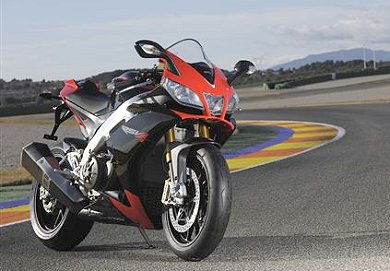
Time for more serious throttle cable stretching (can we still say that with ride-by-wire?) and while still on the middle “S” setting, above 9,000 rpm things get emotional indeed. The creamy power delivery gets all foamy, and the V4 kicks in hard. It’s not a banshee scream, ZX-10 style, neither the berserk hammering of the 1198 twin, the RSV4 has its very own signature power supply quality. The effective, but uneven, engine firing order’s got you thinking the rpm’s are still low, but the revcounter needle is pointing at 13,000. Hold the throttle on and the smart rev limiter slows you down softly before going into full fuel-cutting mode.
Banging at full bore through the gears from 2nd gear Tramonto to the 6th gear “Curvone” the RSV4 shakes its head lightly while gathering speed in deceptive fashion, until it’s time for a decisive peel off at 120+ mph. Even at those speeds, the RSV4 remains highly responsive to direction changes, and yet the front end feels superbly planted and surefooted. The next turn requires some deep braking while leaned over, and the RSV4 demonstrates a healthy appetite for such hard-to-digest situations. No worries of tucking it under at 100! The last station in this trio of decreasing radius turns requires me to really crank her over, and after two-three passes I am dragging my knee all around it. This thing instills confidence, in spades!
Back in the pits it’s time for some mingling with the technical staff. As a gearhead myself, having an in depth tech talk about the pros and cons of buckets (RSV4) versus finger followers (BMW 1000RR?) is pretty interesting. Aprilia had to apply some funky surface treatments like DLC (diamond like carbon) to the valve gear in order to obtain the amazing compactness of the heads while maintaining a good reliability.
Seeing the complexity of the cam drive train is impressive, but, more than anything, it’s the tiny size of the airbox that surprises me. I always thought that you needed quite a bit of airbox volume to make big power, but this one seems to hug the variable height throttle throats really tightly. Looks like I am onto something as the Aprilia staffers mumble:… “well as you can see, it works”….. It sure does, just not so sure how. The not so obvious advantage is that the fuel tank that goes over it can be extremely slim.
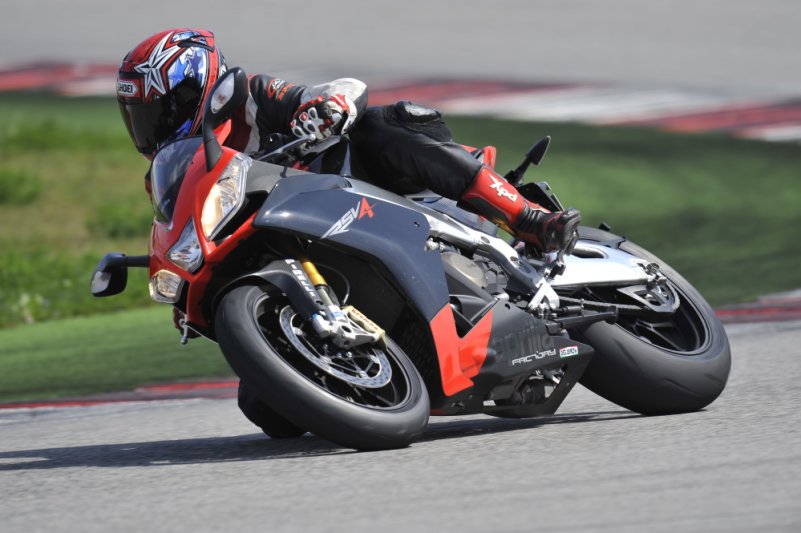
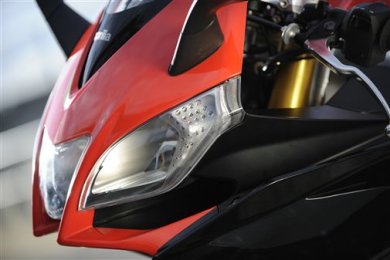
As you can see, there are plenty of gizmos at work here. First, the drive-by-wire (DBW) throttle that, in case you haven’t been following the latest sportbike tech, means that the cable operates just an electronic sensor and the actual opening of the butterflies is handled by a software-controlled electric step motor. The DBW means that it’s also fairly easy to create three different engine response maps, or programs. In the case of the RSV4 you have a full power / no limits T (for track) position, an S (for sport) position that simply softens power delivery in the first three gears where engine power can overcome available traction, and finally, there’s R (for road), a setup that transforms the power delivery to acceptable levels for rainy/low traction conditions.
The variable length trumpets simply help with getting the most torque over the widest rev range. Experienced race mechanics will be happy to hear that the “Factory” version we tested here has endless geometry adjustment possibilities . . . including steering head angle and offset, swingarm pivot position, and even engine height.
Easy to get lost here, but Aprilia just had to build all this into the first batch of 1,500 bikes in order to get WSB homologation. The suspension for this top-of-the-line spec is pretty trick, too, with Ohlins suspenders front and back, which are fully adjustable, but compared to the latest wares from Japan lack hi & low speed circuits. After sampling the extreme control and plushness of these luxury Swedish boinkers, I don’t see a need for speed sensitive adjusters, myself.
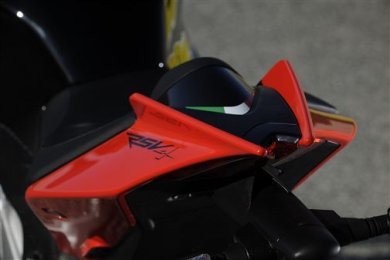
Back on the track, it’s time to start pushing a bit while still on the “S” map. The Aprilia people were happy to point out that some of their very own (and very quick) works testers (such as ex-MotoGP rider Alex Hoffman) have clocked their fast times on the S, rather than T, setting. And indeed, around the two main clusters of 2-3rd gear turns at both ends of Misano, you can nail down the power pretty hard in “S” mode without much concern. At the same time, as you switch to 4-5th for the quicker stretches, you get full 180 horses.
The braking department is well taken care of too, again with more emphasis on control rather than outright power. The secret seems to lie with the pad’s compound, as the hardware is essentially the same setup as on the 1098, which threatened your life every time you dared to caress the lever (the 1198 is also softer than the 1098). In any case, brake as late as you want, all the power is there if you need it, and the hefty 43mm Ohlins fork take it all on with aplomb.
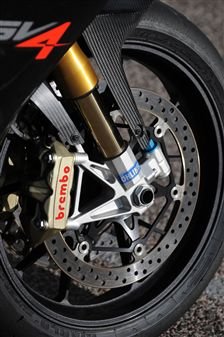
Un-official lap times are never supplied at launches, but by looking at my photographs I was able to learn that I was lapping at around 2:00 during my second session at the “new” Misano. 1:50 is a pretty quick lap on a stock 1000 here, so if a very average racer like me got to 2:00 flat so quickly, and without feeling like I was pushing that hard, then kudos to the extreme user friendliness and downright efficiency of this new RSV4.
When pushing harder and cramming my braking and gearchanging into tighter spaces, I found my only real criticism: the stiffish gear changing. 98% of the time I actually liked the well defined clicks, but after getting two false neutrals I have to say that things could be improved. Part of the blame might be on the not-so-smart, rear facing gear change lever (pivots in front of your foot). Never liked them. I have always preferred levers that rotate with your foot. On a tool like the RSV, skimping on a linkage style gear lever is a mistake.
One last session, and this time on the full afterburners “T” setting. I immediately notice the RSV4 kicks harder in the lower gears, lofting the front wheel with ease. Alas, the extra oomph exiting second gear corners makes it difficult to keep a tight line. I can fully understand why this setting, while exciting, can also get in your way when trying to set good times. On the other hand, if you need further proof that an uneven firing order does work and that Vees do put the power down, here it is. Even on the T setting, the RSV4 simply digs the tires into the tarmac.
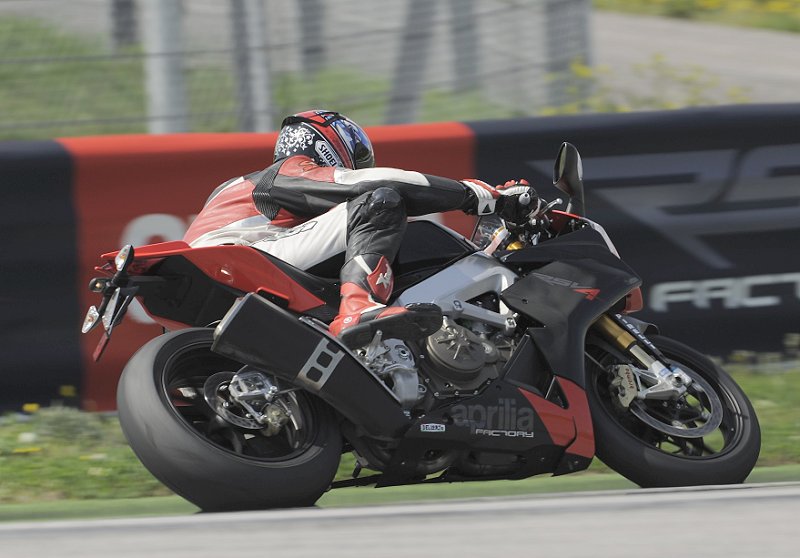
If Japan’s big-four are the masters of the in-line four, and Ducati the magicians of V-Twins, then Aprilia are surely wizards in coming forward with new and untried stuff and making it all work. The more I think about this bike and the amazing riding experience it provides, together with the fact that it was born in a small but passionate R&D center, the more I feel respect for these guys. With a price tag 40% higher than any current in-line four the exotic Factory version might be on the expensive side, but it surely delivers on all the hype, and left this experienced pilot with one indelible memory. Well done.





